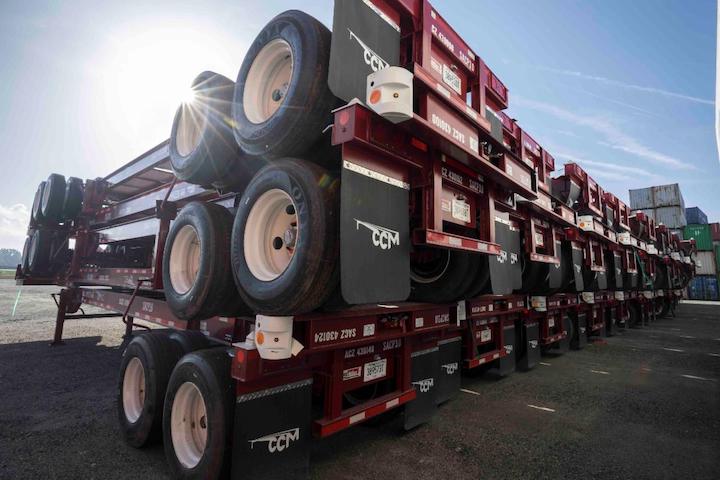
The North Carolina State Ports Authority welcomed the arrival of a fleet of Consolidated Chassis Management’s (CCM) container chassis in July, in preparation for the launch of the latest iteration of the South Atlantic Chassis Pool, known as SACP 3.0. SACP 3.0, billed as a next generation interoperable chassis pool covering the South Atlantic, began operations in early October.
CCM is operating the pool based on a single provider model, in contrast to existing multi-contributor chassis pools. The North Carolina State Ports Authority joined in the establishment of SACP 3.0 together with CCM, the Ocean Carrier Equipment Management Association (OCEMA), the Georgia Ports Authority, and the Jacksonville Port Authority. CCM is increasing and upgrading the existing South Atlantic Chassis Pool with 45,000 new and refurbished intermodal chassis from major regional ports and key intermodal inland hubs.
“It will be one of the largest fully interoperable chassis pools in the U.S., with more than 75 locations in Alabama, Florida, Georgia, North Carolina and South Carolina,” said Mike Wilson, CEO of CCM. CCM, until recently owned by OCEMA, an association of U.S. and foreign ocean carriers, was acquired by Oaktree Capital Management on October 3.
A recent report from the National Highway Traffic Safety Administration (NHTSA), which enforces federal safety regulations on commercial trailers, including container chassis, noted that the chassis shortage is one of the major challenges facing the logistics industry today, a condition it blamed on “increased use and a backlog in domestic production,” which has decreased the availability of road-worthy units.
The launch of SACP 3.0 builds on recent upgrades and infrastructure improvements at the Port of Wilmington designed to better service truckers and the local port-user community. Last year, the Port of Wilmington opened its new South Gate Container Complex, a $26 million project that reconfigured the port’s previous container gate layout used by truckers, increasing the outbound lanes to six and inbound lanes to seven.
Several new technologies are incorporated in the new complex, including weigh-in-motion scales, optical character recognition (OCR) portals, truck radio frequency identification (RFID) tag and license plate readers, and other features designed to reduce truck turnaround times. NC Ports also recently enhanced and upgraded its chassis yard at the Port of Wilmington to include new interchange technology, additional inspection lanes, and a streamlined chassis drop off and pick-up process.
“Our objective with the implementation of our new chassis yard was to do as much work for our truckers in advance of their arrival as possible,” said Doug Vogt, chief operating officer of the North Carolina State Ports Authority. “We added some personnel to expedite the process and to ensure that we always have good order chassis available and ready to go.”
Truckers are required to be registered with the Uniform Intermodal Interchange and Facilities Access Agreement and to sign the CCM contract in order to participate in SACP 3.0.
“SACP 3.0,” according to Vogt, “is focused on chassis quality and availability which aligns well with our focus on improving the trucker experience.”





